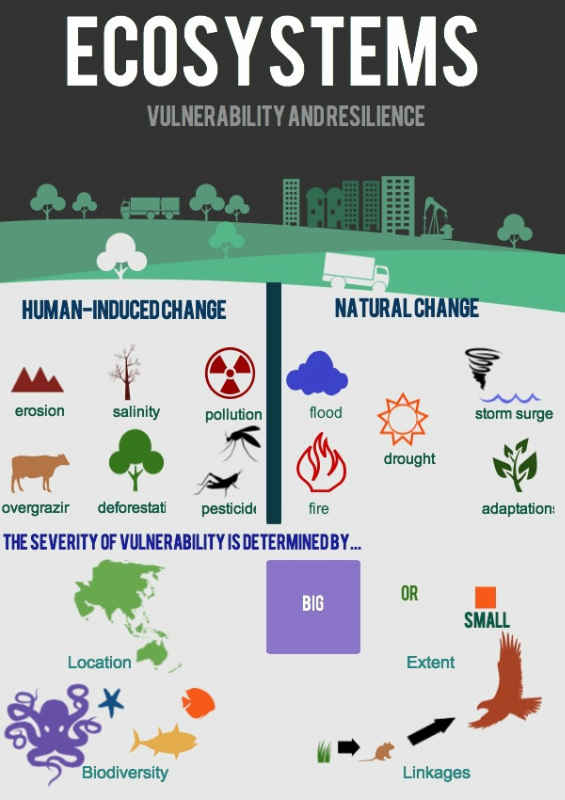Vulnerability and resilience
Causes of Ecosystem vulnerability:
Location
The following locational factors can affect the functioning of ecosystems:
Extent:
Ecosystems that are restricted to relatively small areas or have already been subject to
extensive disturbance are especially vulnerable.
Linkages:
Ecosystems that have low levels of interdependence are much more vulnerable to change. For example if an organism can rely on only one form of producer for its survival, and the producer population is wiped out then the consumer is it great risk of also being wiped out in the area.
Biodiversity:
Example: Rhino - genetic diversity
“Two species of rhino in Asia—Javan and Sumatran—are Critically Endangered. A subspecies of the Javan rhino was declared extinct in Vietnam in 2011. A small population of the Javan rhino still clings for survival on the Indonesian island of Java. The small size of the Javan rhino population is in itself a cause for concern. Low genetic diversity could make it hard for the species to remain viable.”
http://www.worldwildlife.org/species/rhino
Example: Coral Reefs - species diversity
Coral reefs are widely known for their stunning array of color, shape and forms of life, making them a model for extreme biodiversity. Hidden within the multitude of reef inhabitants, but no less important, is their genetic diversity— variability inDNA that gives species the capacity for adaptation, speciation and resilience in the face of stress.
http://www.hawaii.edu/news/2016/04/27/protecting-diversity-on-coral-reefs-dna-may-hold-the-key/
Example: Borneo - ecosystem diversity
“Although Borneo conjures images of dense tropical rainforests, the landscape offers a mosaic of varied habitats: mangroves, peat swamp and swamp forests, ironwoods, heath and montane forests. These areas form part of a complex ecosystem that has evolved over thousands of years.”
http://www.wwf.org.au/our_work/saving_the_natural_world/forests/forests_work/heart_of_borneo/
Location
The following locational factors can affect the functioning of ecosystems:
- latitude
- distance from the sea
- altitude
- microclimatic features
Extent:
Ecosystems that are restricted to relatively small areas or have already been subject to
extensive disturbance are especially vulnerable.
Linkages:
Ecosystems that have low levels of interdependence are much more vulnerable to change. For example if an organism can rely on only one form of producer for its survival, and the producer population is wiped out then the consumer is it great risk of also being wiped out in the area.
Biodiversity:
- genetic: Genetic diversity favours the survival of a species as it increases the chance that some members of the population will have the characteristics to be able to withstand changes in environmental conditions
- species: The greater the species diversity within an ecosystem the more able the ecosystem will be to
withstand threats. - ecosystem: The greater the number of habitats, biotic communities and ecological processes occurring, the easier it will be for the
ecosystem to recover from threats or changes in environmental conditions.
Example: Rhino - genetic diversity
“Two species of rhino in Asia—Javan and Sumatran—are Critically Endangered. A subspecies of the Javan rhino was declared extinct in Vietnam in 2011. A small population of the Javan rhino still clings for survival on the Indonesian island of Java. The small size of the Javan rhino population is in itself a cause for concern. Low genetic diversity could make it hard for the species to remain viable.”
http://www.worldwildlife.org/species/rhino
Example: Coral Reefs - species diversity
Coral reefs are widely known for their stunning array of color, shape and forms of life, making them a model for extreme biodiversity. Hidden within the multitude of reef inhabitants, but no less important, is their genetic diversity— variability inDNA that gives species the capacity for adaptation, speciation and resilience in the face of stress.
http://www.hawaii.edu/news/2016/04/27/protecting-diversity-on-coral-reefs-dna-may-hold-the-key/
Example: Borneo - ecosystem diversity
“Although Borneo conjures images of dense tropical rainforests, the landscape offers a mosaic of varied habitats: mangroves, peat swamp and swamp forests, ironwoods, heath and montane forests. These areas form part of a complex ecosystem that has evolved over thousands of years.”
http://www.wwf.org.au/our_work/saving_the_natural_world/forests/forests_work/heart_of_borneo/
Natural changes to ecosystems can be severe and drastic, resulting in an ecosystem having to adapt or change in a short period of time in order to survive. More often, natural changes occur over an extended period allowing ecosystems to gradually change to suit changing
conditions.
Natural changes to Ecosystems:
Examine links about Charles Darwin and the theory of evolution.
conditions.
Natural changes to Ecosystems:
- Immediate – e.g. drought, flood, fire, volcanic eruptions, storm surge,
cyclone. Immediate natural changes can have a dramatic effect on ecosystems, and
in severe cases can wipe out the ecosystem in it’s entirety. - Gradual – e.g. natural fluctuations in climate, movement of species, adaptation to changes – natural selection. Gradual changes are likely to cause long-term changes to an ecosystem, such as changes to species found and numbers of species, functioning of the ecosystem.
Examine links about Charles Darwin and the theory of evolution.
Human induced changes:
- Immediate – deforestation, overgrazing, ploughing, erosion, pesticides, toxic substances, urbanisation, mining and war
- Gradual – salinisation and soil waterlogging, compaction and erosion, pollution, habitat loss, species loss, loss of biodiversity, introduction of exotics, climate change
Ecosystems need diversity to survive
Genetic diversity gives hope to Tassie Devil.
Endangered tiger quoll spotted in Grampians for the first time in more than 140 years.
Vulnerability and resilience PPT.
Genetic diversity gives hope to Tassie Devil.
Endangered tiger quoll spotted in Grampians for the first time in more than 140 years.
Vulnerability and resilience PPT.
| vulnerability_and_resilience_of_ecosystems.docx |

